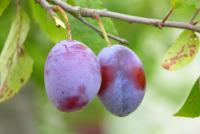Planting and pruning plums in the fall and spring. Lilac, ripe, garden - the secrets of proper plum planting in the fall
It's no secret that for good harvest Seeds are of paramount importance and need care in autumn. You can prepare the seeds yourself, but unfortunately it does not work for everyone, but you can contact a reliable company, for example"4 SEASONS",which has been working in this market segment for many years and sells only Yakіsne nasіnnya, seeds that give excellent shoots and a wonderful harvest. And besides the seeds, here you can buy everything you need for your country house, starting from the inventory and ending with fertilizers for various crops. But to the topic ...
If you need to transplant the plum to a new place, then you must follow the main rules:
The best time for transplanting is early spring or autumn, but in the latter case, transplantation should be done before the onset of frost, the ideal option is the end of September. If in your living area the frosts on the ground begin already at the end of August, then the autumn transplant for plum will be disastrous.
For transplantation, formed trees, up to five years old, are most suitable. The plum of an older age does not tolerate the transplant and is likely to die during it.
And so, you need to start with the preparation of the pit for transplantation. To do this, in advance - no later than 20 days, you need to dig a hole half a meter deep and with a diameter of at least 60 cm. If the land in your area consists mainly of sandstone or peat, the hole rumbles 10 cm deeper, and these extra centimeters laid out a layer of clay.
Then, after 20 days, the plum needs to be dug around the root system according to the size of the prepared pit, and, going beyond the size of the earthen clod, the roots should be cut and cleaned, and the coma should not be destroyed. It is best to dig up the tree immediately before transplanting. Carefully place the dug-out plum into a piece of burlap, or better, polyethylene, and drag it to the transplant site, taking care not to destroy the earthen clod.
Next, you need to carefully lower the plum into the pit, carefully remove the earth from the coma around the roots, there should be no empty space, while ensuring that the roots of the tree are directed downwards, if necessary, straighten them, and after the clod is tightly tamped , you need to fill the hole with loose soil so that its layer was above the level of the soil. Pit around the trunk to a depth of about 10 cm, and pour plenty of plum, usually a pair of buckets of water. Sprinkle the watering place with a layer of earth.
Beat a stake on the north side near the trunk and use a rope to attach a tree to it.
Remember that after transplanting plum needs to be watered every day, but you should not flood the tree, one bucket will be enough.
There is another secret - plum does not like loneliness. and in order for the harvest to be excellent, plant a row, at least one more tree.
Transplanting plums in the fall: basic rules
Plum, along with apples and pears, is extremely popular with gardeners - it is unpretentious, resistant to cold, it survives well and bears fruit not only in the southern regions, but also in the central belt. Sometimes we need to transplant a mature tree to a new place. This is easy to do, but you should follow the basic rules and conditions of transplantation. .
GENERAL RULES OF TRANSFER
It is necessary to transplant the plum in early spring or in the autumn, when the tree “falls asleep” and all its life processes are suspended - then it hurts it less. If you need a transplant of plums in the fall, it is better to do it at least 30 days before the first steady frost that can destroy the roots of a plant that has not yet taken root.
Young plums are best experienced by transplanting; overgrown trees older than five years will most likely endure this process badly - their roots are significantly damaged, they weaken and are sick a lot.
Preparing the soil for transplanting should be done in advance: in three to four weeks, so that the earth can settle down properly, it needs to be dug up, prepared pits for the root lump and fill them with humus. The diameter of the pits should be at least 60 * 60 cm or a little more, the depth should be at least 50 cm. For sandy, peaty soil, lay clay at the bottom of the pit (8-10 cm layer).
Immediately after transplantation, the plant will require abundant watering every day, so transplanting plums in the fall will be more successful if you check with the weather forecast in advance and do it for prolonged autumn rains.
PUMPING DRAIN
In order to help the plum to move the transplant more easily, it is necessary to dig, together with the earthen tree, the size of the prepared pits. All the roots that go beyond it, you need to carefully chop off with a sharp ax, and then clean it with a knife.
Tightly wrap the resulting cone of the earth with wet sacking or spunbond, lutrasil, make sure that the earth does not crumble! On the safety of coma depends on the health of the plant at the site of transplantation.
If transplantation is planned immediately, lay the tree on a wide polyethylene film and move it, better dragged, to a new place.
If you need to transport the plum over long distances, or if you want it to lie down before planting, the clay talker can help the roots survive storage outside the ground: dilute the clay to a mushy state, add some fresh manure to it, dip the peeled roots into this mixture, let them dry out.
Then rewrap the com tightly - in this state the drain can be stored for quite a long time, just do not forget to water it regularly.
For better preservation, you can remove most of the foliage from the tree, however, if you plan to transplant the plum in the fall, do not prune its branches - this should be done in the spring.
DRAINING DRAIN
Carefully move the tree to the prepared pit. In the middle of the hole on the north side, drive a peg.
It is more convenient to transplant a tree together: one holds it and shakes it periodically - there should be no free space between the roots. The second - straightens the roots, sends them down, sprinkles with earth and tamps the soil with his hand.
After the main shrinkage, add loose earth just above the general level of the soil, arrange a hole around the tree in the shape of a pit.
Liberally pour the soil (one or two buckets per plant).
After the first watering, once again sprinkle the hill with earth, so moisture will remain better. Tie the plum to the cola. The transplant is complete!
When replanting a plum, do not forget that it needs sunny, moist areas for proper development, and for abundant fruiting - plant another tree in the neighborhood. Follow the rules of transplanting plums in the fall and spring, and your tree will delight you with health and a rich harvest for more than one year!
The use of information materials from the site (novost.top) is possible only with the permission of Novost LLC (the Novost newspaper editorial office). Reprinting and use of informational articles, advertising layouts without the permission of Novost LLC (the Novost newspaper editorial board) is prohibited!
Instruction
It is possible to replant a tree only in strictly certain terms. Prepare the tree in advance and landing pit. The most the best time for this work is the end of November - the beginning of December. The optimal temperature for a transplant is minus 2-3 degrees. You can also plant a tree in early spring, when the earth is still frostbitten.
A fruit tree, which is 7-10 years old, must be transplanted with a clod of earth. It should have a diameter of about 100 cm and a height of 70 cm. Roots that go beyond these boundaries should be cut off with a sharp ax. Often they are sawed off with a hacksaw. All ends of the roots must be stripped with a sharp knife. Learn, the crown of the tree can be cut only in the spring, before the buds swell. The transfer date does not affect this.
Plum, which is more than 5 years old, needs to be transplanted especially carefully. First you need to dig out the grooves from three sides 50 cm from the trunk. Their length should be at least 60 cm, and the depth - at least 50 cm. Fill the pits with loose nutrient mixture. It should consist of 40% of rotted manure, 20% of sand and 35-40% of the land of the upper fertile layer. Manure and organic residues will eventually decay, while emitting gases. At the exit to the surface many tiny holes will be formed. This will ensure the path of oxygen to the roots. This will have a positive effect on the survival of the transplanted tree. Tamper well and fill the grooves with water. The base of the branches is recommended to be tied with sacking. About a month this strapping need to moisten with water.
During a year plum water regularly and protect from pests. A year will be enough for a powerful beard of small suction roots to grow on the cut roots. By the end of August, when the growth of shoots is stopped, it is necessary to trim the crown.
Transplantation of a tree may be necessary in the case of a new building in its place, expanding a recreation area or a playground. For the success of transplanting a large tree you need to know the important details of this work.
You will need
- Strong shovel, pruner, clay, charcoal, fertilizers, water.
Instruction
Replanting normally tolerate conifer trees. For example, pine, thuja, fir, spruce and many others. When transplanting the tree will have to dig along with the roots. Consider that some trees develop roots that go far to the sides. If they are disturbed, the tree can then be very sick. Before transplanting, dig a trench around the tree in a width of 30 cm and a depth of at least 60 cm. Cut the roots in a trench with a sharp device or cut with a pruning shears. After that, sprinkle the roots with charcoal or coat with garden putty, clay. Pistol circle loosen and add fertilizer. Now the tree is ready to transplant.
Choose a location for a transplant. It should be comfortable for the tree: in the shade or in the sun, with wet or, on the contrary, arid soil. Prepare a landing hole 15 days before the transplant. Digging a hole, pay attention to the condition of the soil. If it is severely depleted, replace it with fertile. The average depth of the landing pit: 1 meter. More depth is not desirable, since root system from this can rot. The width of the pit determine the width of the earthen coma on the roots. Before transplanting, pour humus on the bottom of the landing pit.
Proceed to planting a tree: insert a sturdy shovel into the dug trench and try to push it under the roots. If not, remove more soil on both sides of the plant. Try again to loosen the grip of the roots with the soil. When you see that the roots are loose, move the tree to the burlap spread next to it. Bind a tree with sacking: so you keep an earthy ball on the roots. Now it is desirable to moisten the burlap with water.
Grasping the edge of the burlap, transport the tree to the new pit. Untie the burlap and firmly place the tree in the pit of earth. Throw a hole in the prepared soil and well tamp so that there are no voids inside. After this, pour the tree and again firmly tamp. If there are air pockets in the soil, the tree can easily budge. For watering will be enough one bucket. After watering the tree every three days for 1.5 months. Put the mulch in the tree circle: this will allow the soil to stay wet for a long time.
Deciduous tree Replant in early spring, as soon as the snow melts. Rowan, horse chestnut, bird cherry, apple, irga, plum, quince, pear and many others tolerate transplant well. To protect the bark of a transplanted tree from drying out, tie moss, bark, rags, a layer of straw or cardboard to it. In the spring of the previously transplanted tree, be sure to shorten all unnecessary ramifications. If it is possible to priten the tree after transplantation, be sure to do it. So the root system will recover faster and come in line with the aboveground part of the tree. Also, after transplantation, additional irrigation with root formation stimulants is recommended - “Heteroauxin”, “Rootomy” and others.
note
Before digging up the tree, mark the side of the plant that faces north. And when transplanting plant a plant in the same spatial arrangement.
If you transplant a plant from the forest, grab a couple of buckets of earth and mix it with a garden one.
Plum - one of the favorite fruit crops of gardeners. Its varieties differ in the form of fruits. The elongated oval fruits are in the Hungarians, and the spherical fruits are in the green leaves. However, planted trees may not bear fruit or die. The reason for this often lies in the improper planting of seedlings, and the plum is very demanding on growing conditions.
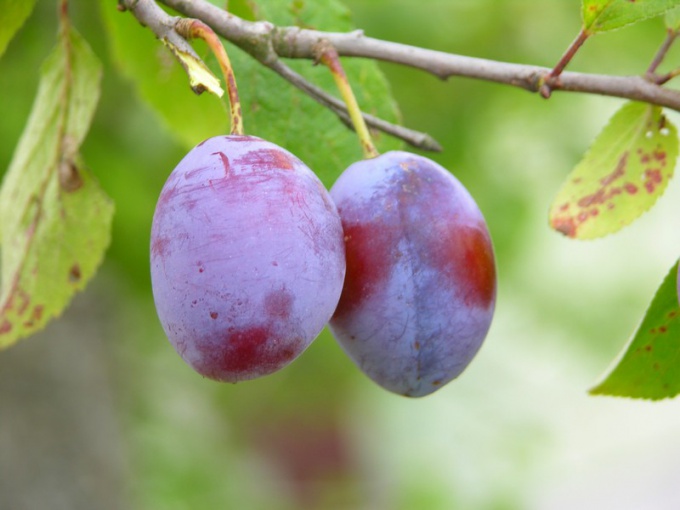
You will need
- - seedlings;
- - stakes or wire;
- - garden tools;
- - tags indicating the grade.
Instruction
Choose a place for the seedling on the site. Plum prefers moisture-retaining, well-drained soil with a pH of 6.5-7.2. Does not like the plum tree of the winds, and in low places flower buds can be damaged by frost. Pick a warm, well lit place. Well, if the wind will be drained from the wall of a house or fence.
Plums are planted mainly in autumn or spring (plants with a closed root system can be planted in summer). Prepare the soil. Remove perennial weeds and apply mineral and organic fertilizers. In open places, provide planting stakes, and if you plan to form trees in fan shape, then pull the wire system.
Pick a good planting material. Remember, for the best survival of the seedling it is necessary that it meets certain requirements: the length of the roots is at least 30 cm, there should not be cancerous growths on the roots and trunk, without nodules in the inoculation site. The length of the trunk is at least 60 cm, the thickness of the trunk is 2-2.5 cm.
Dig a planting pit of such a width and depth that the straightened roots of a sapling can be freely accommodated in it. A pit of 40x60 cm is enough for draining. Fold the fertile top layer of the earth separately. In the other direction, remove the lower less fertile layer of soil. Arrange drainage at the bottom of the pit.
Inspect plum roots. All broken, crushed and torn ends cut off with a sharp knife or shears. Carefully place the seedling on a mound of fertile land poured into the pit. Gradually pour the ground to the roots. Try to wake up the soil between the roots and evenly fill all the gaps. The tree will survive much worse if there are voids between the roots.
The root neck of the tree (the place of transition of the trunk to the roots) should not be underground. To do this, put a sapling slightly higher than necessary. Over time, the soil will settle, and the root of the neck will be in place. Tie up plum to cola or to wire. Liberally water the tree.
It is necessary to place saplings in a row, not less than 3-4 m from each other. Keep tree trunks clean. Land under seedlings can be mulched. If you plan a garden under vegetation, then mow the grass regularly.
note
Remember to loosen the ground around the plums with caution, because the root system of trees is very close to the surface.
Helpful advice
Be sure to hang tags on seedlings indicating the type and date of planting.
Sources:
- how to plant a plum in the fall in 2017
To refresh the water in aquariumit is not enough just to drain the old one and pour fresh from the tap. Over time, a special microclimate is formed in the tank, due to the abrupt change of which the fish may become ill or die. If you do not want to harm those who are so diligently nurtured, while draining and filling the aquarium, follow a certain sequence of actions.
Planting trees is a necessary and important procedure. Very often, for this, it is necessary to re-plan the dacha plot and move the plantations in order to free up space for the construction process.
Often, a tree is required not only to be transplanted from one place to another, but also to be transported from one garden to another. One way or another, the issue of transplanting a plum tree with minimal root injuries remains topical among gardeners.
First, you need to decide on the most favorable time to move the plum tree. This process is optimally carried out before the onset of intensive plant development. In other words, the season of spring April or autumn October is best suited for such a task. In the second case, the specific time possible for replanting plums is until the twentieth of October. Then there will be a little less than thirty days before the first frost.
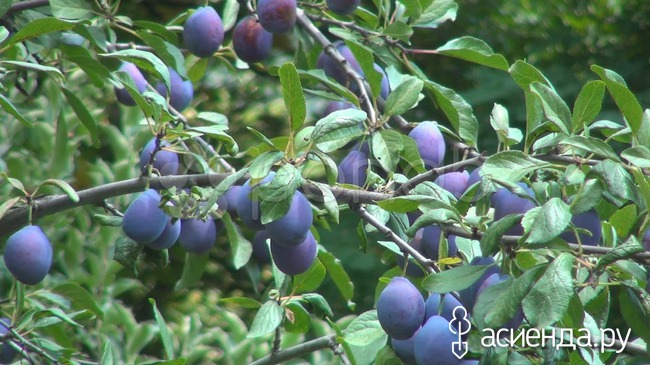
Secondly, many people are interested in the question, is it possible to replant a plum tree in the month of May? Although trees can be transplanted in late spring or summer, this can only be done in the most extreme cases. In addition, if the transplant occurred during this period, then this year you can not count on the fruits, and if the roots were damaged, then the break will be delayed for two years.
The best tolerated transplant trees, whose age has not yet reached four years. One or two year old saplings take root in any soil. As for old trees, their roots are branched in character, but, moreover, small new roots gradually grow in the root system. It is for this reason that old trees take root for a long time and badly, changing their location. To speed up the process of adaptation of the tree in the new conditions you need to transplant it together with a piece of land from the old place. Also, this condition will help to preserve a larger number of roots.

Often, among summer residents, another interesting question arises - is there an opportunity to replant plum seedlings? The answer is actually quite simple: if the tree is grafted, then there is no point in moving the young shoots from the roots. The fruits in this situation will be small, and the taste will begin to sour. But in the situation when the question arises about high-grade trees with large fruits, then the processes can be separated from the roots and planted at a new location.
The process of transplanting begins with the preparation of a place for a new tree. In the autumn time, the pits for the root system of the tree are prepared in about twenty days. But if the transplant is planned for spring, then the pits must be created already in the autumn season. Dimensions of the pit must also meet certain standards. So its width will be approximately 80 centimeters more than an earthen coma. More precisely, to plant a two-year-old tree, fit a hole with a size of 70 by 70 centimeters. The same should be its depth. After all this, a drainage layer is placed at the bottom of the recess. As it is well used clay or brick. Such material well protects the root system from moisture stagnation. This is especially true when the groundwater at the dacha is close to the surface. The next step is to put a layer of compost into the pit, and a layer of earth on top of it. This will help the roots to avoid direct contact with the fertilizer.
Remove the seedling from the ground also need to correctly and correctly. In carrying out this process, you need to initially pour about five buckets of water, and then dig around the tree around the circumference. After this, it is necessary to cut an earthen clod in the shape of a cone, the depth of which will be approximately seventy centimeters. Then you can gently pull the seedling.
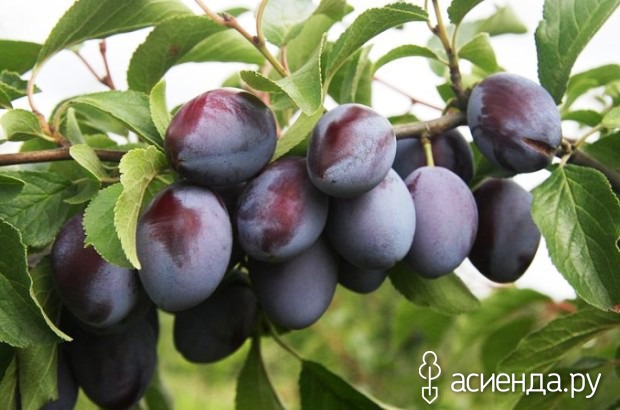
After transplantation, it is worth taking care of the care of the plum tree, so that it quickly settles in a new place and gives fruit. Undoubtedly, the conditions for the development of plums should be as comfortable as possible. This tree loves heat and moisture. Therefore, if you plant a tree in the shady part of the garden, its yield will decrease several times. An important role here is also played by the soil composition. Dense soil will not be the best solution for the active growth of plums. In such a soil moisture stagnates, not allowing to penetrate into the roots of a tree. It is better to choose a place with loose soil, where the sun falls, warming the ground.
Worthy yields to you!
In the big garden or the cottage there will surely be a tree that yields a harvest of sweet and fragrant fruits. If on your site plum does not grow, it's time to plant it. By the way, they usually do it in spring or autumn. Well, in our article we will discuss how to plant a plum in the fall.
Autumn planting plums - the choice of place and time
Since plum is a light and heat-loving culture, the best site for it will be small hills or hillsides where the sun's rays fall. At the same time, the site should be protected from strong winds. The tree is suitable fertile, but at the same time, loose soil. Wetlands and land with groundwater above 1.5 m are not suitable for this purpose.
If we talk about when you can replant the plummer in the fall, then it is best to choose the day at the end of September, when there is no frost yet. It is important that the tree sap slows down, but at the same time it has managed to get used to the new place.
How to plant a plum sapling in the fall?Two weeks before planting, you need to dig a hole to a depth of 60 cm and a diameter of about 80 cm. Fertilizers mixed with the excavated earth are placed on the bottom (bucket of rotted manure, potassium salt 65 g, superphosphate 350 g). If the soil is dense, it can be mixed with sand to improve drainage properties.
When choosing a seedling, pay attention to the plum seedling with a strong root system. For planting it is optimal to use a one or two year old sapling. It is lowered into the landing pit, gently straighten the roots and fall asleep the ground, occasionally trampling it. It is important that the root collar was located at a height of 3-4 cm from the ground level. If necessary, for a tree, they stick a stick in the hole, which will become a support for an unstable plum. Then the tree is watered and mulched with peat or.
If, due to circumstances, it is necessary to plant the seedling late in the fall, then for better wintering, the plum needs to be buried in a small ditch obliquely and almost completely covered with earth, peat, and in winter with snow. And in April, a young tree can be transplanted to a permanent place.
How to transplant the plum in the fall?
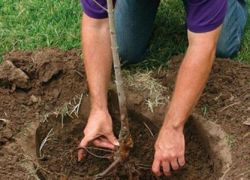
It happens that a gardener needs to transplant an adult plum to another place, for example, more lighted or closer to other types of plums, which will help to improve yield. Keep in mind that the “relocation” is well tolerated only by young trees under the age of 5 years. For two weeks, before transplanting the plum in the fall, dig a hole in a new place and place fertilizer on its bottom. The tree is dug together with an earthen ball. Earthen ball is recommended to tightly wrap a wet burlap. Then the drain is carefully placed in a prepared pit along with burlap, covered with earth, trampled, watered with 1-2 buckets of water and mulched.


